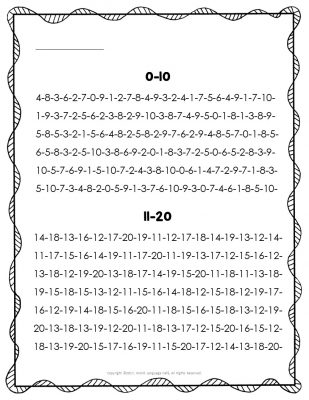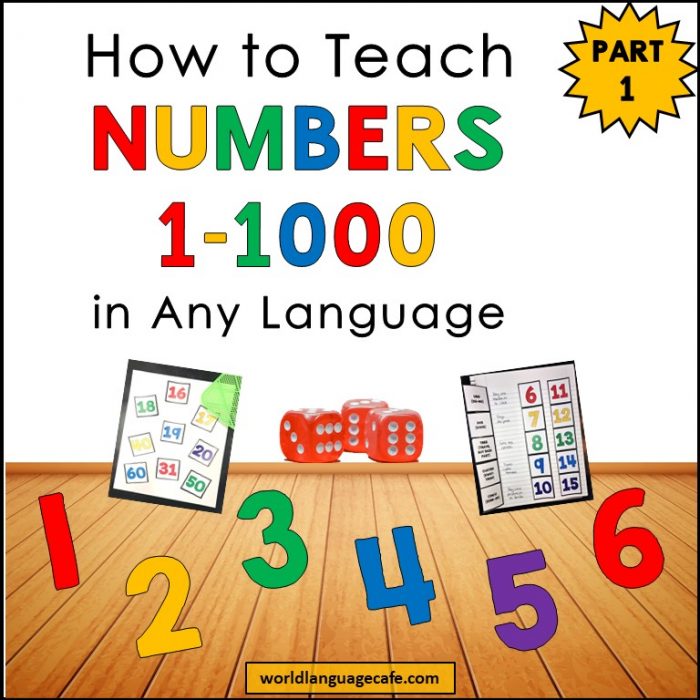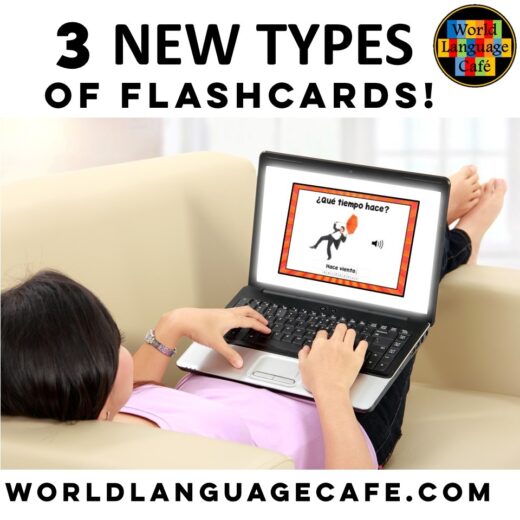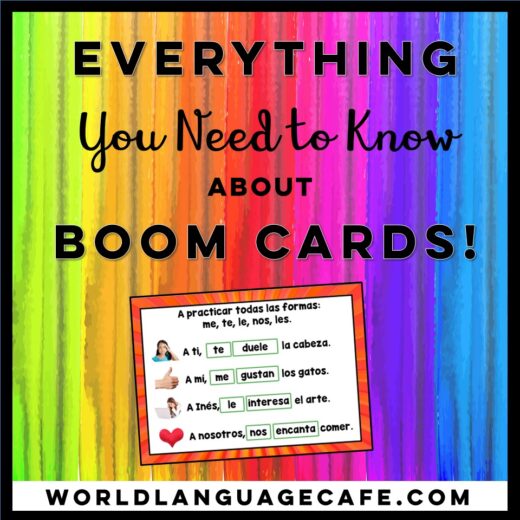How to Teach Spanish Numbers, French Numbers 1-20, 1-100, 1-1000
Teaching numbers in another language is easy, right? Yes, but are you really teaching your students to master the French or Spanish numbers with fluency or only to be able to say a number after they’ve counted all the numbers before it?
Be honest – how many times do you see your students counting in their heads just to say 13?
For many years, my students did the same thing, but when I raised my own kids bilingually and taught kids ages 3-7 out of my home, I learned a better way. In Part 1 of Teaching Numbers in Any Language (#1-12), you’ll learn my tried and true methods that work well with all ages and grade levels.
1. Start by teaching numbers 1-6.
Go through the numbers 1 by 1. Focus on each one for 1-2 minutes before moving on to the next one. Do not write anything on the board yet.
- Whenever you’re teaching new vocabulary, always present it orally first. If you show students the words first, they create an imaginary pronunciation in their heads and it’s very difficult to change this first impression. Makes a huge difference in their accents if they hear and repeat the words several times before seeing them.
- As language teachers we often give too much new info. at once. Most people know 1-6 in Spanish, but struggle with 7-12. Master 1-6 before moving on.

Spanish Numbers 1-6, French Numbers 1-6
- Say each number in funny voices, loudly, softly, fast, slow, high pitched, low pitched, etc. The goal is to have students repeat each number as many times as possible (20-40 times).
- Move your hands and have your students mimic the movement while you’re saying each word. It doesn’t matter which movements you do. Go with what comes naturally. Students repeat the word each time you say it.
Ex. Dance and Make a square with your index finger. Say a number as you draw each side of the box. Put your hands above your head, arms extended in the air, palms up, and swivel your hands like you’re celebrating. Say the number as a cheer.
2. Teach students a full body physical movement to go with each number.
Again, it doesn’t matter which movements you use. Getting students up and moving around is just another way to keep them engaged while you’re repeating numbers. (Think of how much of their day is sitting. This is your chance to make language class the best class in the school – yup, even better than gym or lunch).
- 1 – Whole body in a straight line with hands together overhead, palms touching.
- 2 – Same, but hands spread wide apart.
- 3 – Same, but right leg goes out to the side, touching the ground.
- 4 – Same, but left leg goes out to the side.
- 5 – Plug your nose with your fingers, put the palm of your other hand up in the air and pretend to be sinking underwater and blowing bubbles. (In Spanish and French, the word sound like sink or sank thus the sinking motion).
- 6 – Both palms flat on the ground.
3. Have them roll dice and say the numbers.
Pass out 1 die to each student or use online dice. Remember, you want your students to know these numbers fluently and be able to say the numbers out of order without counting. Have them do this until they can say each number as fast as they would in English.
- Variation: Have them do this with one die in partners and see who can say the number first.
- You can find 100 packs of dice online. I suggest splitting the cost and the dice with another teacher or requesting that the department buy a set.

Dice Numbers 1-20
4. Next teach numbers 7-12.
Repeat the whole body movements, adding additional movements for these numbers.
5. Have students practice counting from 1-12 while they are jumping, hopping on one foot, hopping on the other foot, clapping, etc.
Repeat this with only even numbers and then only odd numbers.
6. Do the dice exercise again, but with 2 dice this time.
First have them say the total number. Then advance to saying, “3 + 5 = 8”. Repeat the same activity with 3 dice.
7. Have students practice “reading numbers”.
Use the number reading sheet in my Free Resource Library. Students read the numbers just as they would read a paragraph. Great for increasing number fluency.

Numbers 1-20 Reading Sheet
8. Assign Boom Cards for an in-class assignment or for homework.
Grab decks of Spanish numbers Boom Cards for whichever numbers you’re teaching.
1-20 20-100 1-100 100-1000 1000-1.000.000
9. Give students cards with a picture of an object on one side with the word in the target language and a certain number of those same objects on the other side.
Students walk around asking how many of certain things each student has and then write a sentence about it.
Ex. How many dogs do you have? (Then they write down, “Suzy has 6 dogs).
10. Use numbers in context for communication.
Students ask for each other’s phone numbers. On a piece of paper, they write down the number next to the person’s name. That way, they have to listen, understand, and write what they hear, just like they would during a friendly conversation.
Ask about how many family members students have in their immediate families and their extended families.
Use these activities and before you know it, your students will have permanently mastered Spanish numbers 1-20 in the target language (plus you’ll have squeezed in some extra grammar and communication skills). Like sneaking vegetables into your kids’ spaghetti sauce. He, he.
Remember to get your number reading sheet, and many other goodies.
And be sure to read on to the next part in this series, “Teaching Numbers, Part 2” to learn how I teach numbers 13-1000.
Happy Teaching!
~Sherry





2 Comments
Tara Brown
March 11, 2018 at 11:26 amThx for the link to buy dice! They are way cheaper than I thought they would be for that many! I used to go to garage sales and buy board games for $0.25-ish that had dice so we could use them in class. Of course, over the years they have slowly (but surely) disappeared. With your link, you really can’t beat 100 dice for less than $10! Yay!
Sherry Schermerhorn
March 21, 2018 at 9:06 pmI searched for the cheapest price I could find. 🙂